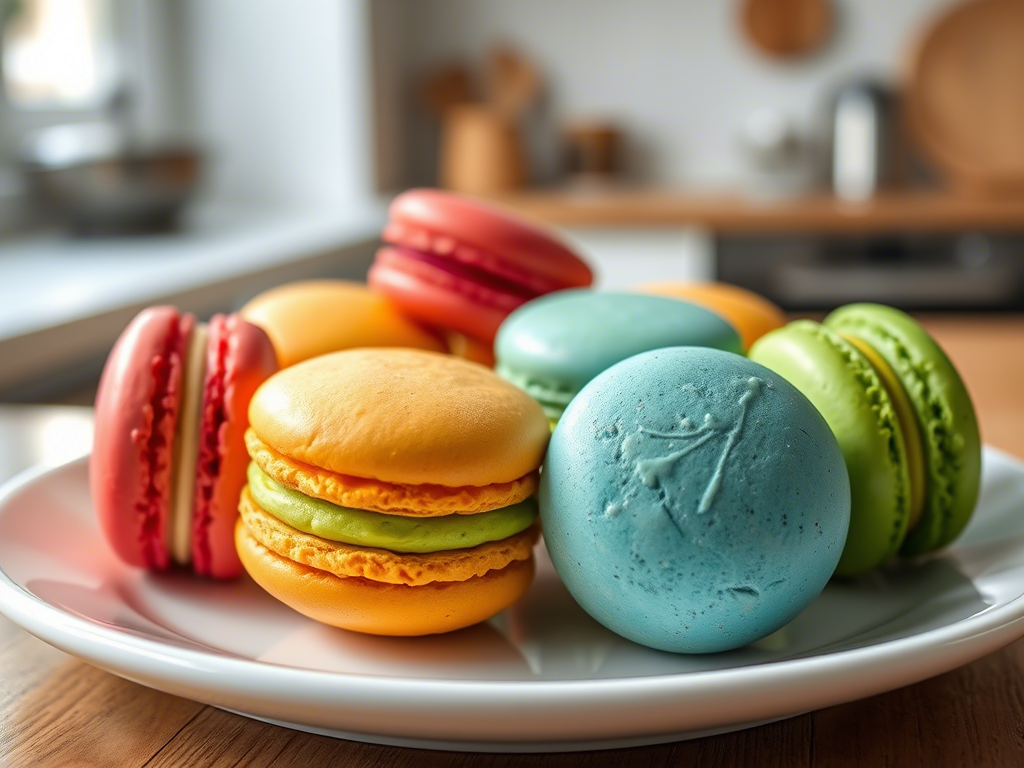There’s something magical about biting into a perfectly crafted macaron. Its delicate shell gives way to a smooth, creamy filling that bursts with flavor, leaving you in awe of its simplicity and sophistication.
Whether you’re an aspiring baker or simply someone who loves indulging in sweet treats, learning how to make macarons can be both rewarding and challenging.
This article will guide you through the process of mastering this iconic French delicacy, offering practical tips, troubleshooting advice, and inspiration to help you create flawless macarons at home.
In this comprehensive guide, we’ll cover everything from understanding the basics of what makes a macaron unique to advanced techniques that elevate your baking skills.
By the end, you’ll not only know how to bake these delightful confections but also understand why they’ve captured the hearts (and taste buds) of so many around the world. So grab your apron, preheat your oven, and let’s dive into the art of making macarons!
Understanding Macarons: What Makes Them Special?
At first glance, macarons may seem like just another cookie, but their charm lies in their complexity. A true macaron consists of two almond meringue shells filled with ganache, buttercream, or jam. The key to success is achieving the perfect balance between texture and flavor—a feat that requires precision and patience.
The outer shell should have a glossy finish with a slight crunch, while the inside remains tender and chewy. Achieving this ideal consistency involves mastering the art of “macaronage,” which refers to mixing the batter until it reaches the right viscosity. Overmixing or undermixing can ruin the structure, resulting in flat or cracked shells. Additionally, proper resting time allows air bubbles within the batter to stabilize, creating those coveted feet (the ruffled edges at the base of each macaron).
Understanding the science behind macarons helps demystify common pitfalls. For instance, did you know that humidity levels can significantly impact the outcome? If your kitchen is too humid, your macarons might spread instead of forming neat rounds. Armed with knowledge, even beginners can troubleshoot issues effectively and improve over time.
Essential Ingredients and Tools
Before diving into recipes, it’s crucial to gather all necessary ingredients and tools. High-quality materials are essential for crafting authentic macarons:
Almond Flour : Finely ground almonds provide the foundation for macaron shells. Opt for blanched almond flour to ensure uniformity.
Icing Sugar (Powdered Sugar) : Adds sweetness and stabilizes the mixture by absorbing excess moisture.
Egg Whites : Use aged egg whites for better stability during whipping. Let them sit uncovered in the refrigerator for 24-48 hours before use.
Granulated Sugar : Necessary for whipping stiff peaks when making Italian meringue.
Food Coloring : Gel-based colors work best as they don’t alter the consistency of the batter.
Filling Options : Ganache, buttercream, or jams allow endless creativity in flavors.
As for tools, here’s what you’ll need:
- Stand mixer or hand whisk
- Silicone spatula
- Piping bag fitted with a round tip
- Baking sheets lined with parchment paper or silicone mats
- Oven thermometer to monitor temperature accuracy
Investing in quality equipment ensures consistent results and minimizes frustration. Remember, baking macarons isn’t about having fancy gadgets—it’s about using reliable tools that perform well under pressure.
Step-by-Step Guide to Making Macarons
Now that you’re familiar with the fundamentals, let’s walk through the steps to make your own batch of macarons. Follow this method carefully, paying attention to details along the way:
1. Prepare Your Workspace
Clear your counter space and measure out all ingredients beforehand. Preheat your oven to 300°F (150°C), ensuring it’s fully heated before baking.
2. Create the Dry Mixture
Sift together almond flour and icing sugar twice to remove lumps and aerate the mixture. Set aside.
3. Make the Meringue
Using clean, grease-free bowls, beat aged egg whites on medium speed until foamy. Gradually add granulated sugar while continuing to whip until stiff peaks form. For Italian meringue, heat sugar syrup to 248°F (120°C) and slowly drizzle it into the beaten egg whites.
4. Combine Wet and Dry Mixtures
Fold one-third of the meringue into the dry mixture to loosen it. Then gently incorporate the remaining meringue in three parts, using circular motions without deflating the batter. Stop mixing once the batter flows smoothly off the spatula in a ribbon-like stream.
5. Pipe Shells
Transfer the batter to a piping bag and pipe circles onto prepared baking sheets. Tap the trays firmly against the counter to release trapped air bubbles.
6. Rest the Shells
Let the piped macarons rest uncovered for 30 minutes to develop a skin. This step is critical for achieving proper feet.
7. Bake
Bake for 12-15 minutes, rotating halfway through. Once done, cool completely before removing from the tray.
8. Assemble
Sandwich cooled shells with your chosen filling and store in the refrigerator overnight for optimal flavor development.
Common Challenges and Solutions
Even experienced bakers encounter challenges when working with macarons. Here are some common problems and ways to fix them:
Cracked Shells : Often caused by overheating or insufficient resting time. Adjust your oven temperature and ensure adequate drying.
Hollow Centers : Likely due to overmixing or improper baking time. Practice macaronage technique and experiment with timing.
No Feet : Insufficient resting or uneven piping could prevent feet formation. Be patient and practice consistency.
By identifying and addressing these issues early, you’ll refine your technique and produce better results every time.
One of the most exciting aspects of making macarons is experimenting with flavors. Classic combinations include pistachio and raspberry, chocolate and hazelnut, or vanilla and caramel. However, feel free to think outside the box!
Consider seasonal fruits, spices, or herbs to craft unique profiles. For example, lavender and lemon pair beautifully, while pumpkin spice adds warmth to autumnal creations.
When developing new flavors, remember to balance sweetness and acidity. Too much sugar can overpower subtle notes, whereas tangy elements enhance overall complexity. Don’t hesitate to sample small batches before committing to larger quantities.
Inspiration Beyond the Basics
Once you’ve mastered basic macarons, consider expanding your repertoire. Techniques such as adding edible glitter, marbling effects, or incorporating unconventional textures take your desserts to the next level. You can also explore savory options, pairing cheese fillings with herb-infused shells for a gourmet twist.
Participating in online communities or attending workshops provides additional motivation and support. Watching tutorials or reading blogs written by professional pastry chefs offers fresh perspectives and innovative ideas.
Conclusion
Making macarons may appear daunting initially, but with dedication and practice, anyone can achieve success. From understanding the importance of ingredients and techniques to embracing creativity and experimentation, this journey fosters growth and enjoyment.
Remember, perfection doesn’t happen overnight—embrace failures as stepping stones toward improvement.
We encourage you to try making macarons today and share your experiences with others. Leave a comment below sharing your favorite flavor combination or ask questions if you’re stuck. Together, let’s celebrate the joy of baking and savor the beauty of macarons!
Happy baking!

Thayná Alves is an influential digital content creator who has carved out a significant space in the realms of technology, finance, and entrepreneurship. Through her blog, Newbacker.com , she stands out as an authentic and accessible voice for individuals seeking practical information about investments, innovation, and emerging trends in the financial market.


